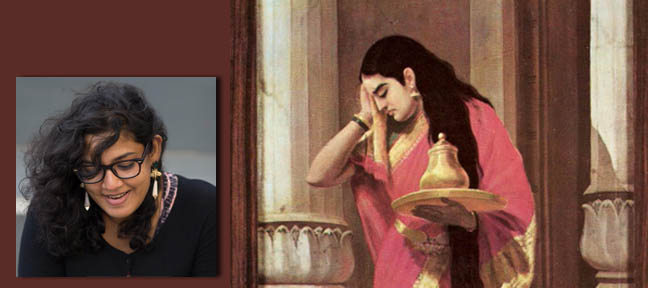Article in PDF (Download)
The Fair Face of the Epic – A closer look at women in Mahabharata by Aryaa Naik
Love, eternal love, a grand wedding, wedded bliss – these are bright colourful concepts that paint every girls imagination while growing up. Reality, however tends to fade the colours a little. The Mahabharata is a testimony to this.
In this epic tale, it was the women who defined and redefined power and influence. They were seen as both positive and negative, associated with prosperity and destruction, but they all had one thing in common, they were all deceived in some way or the other as far as love and marriage were concerned.
Renowned Linguist, Academician and Sanskrit Scholar Dr. Sucheta Paranjpe has shed light on this aspect of the women in Mahabharata in many talks and lectures. Based on the Mahabharata Critical Edition – BORI (Bhandarkar Oriental Research Institute, Pune) Dr. Paranjpe has unraveled the threads of deception faced by different women at different times in the Epic. She points out that each female character in the Mahabharata was deceived or cheated in some way or the other, but this did not mean they were victims, they found a way to carve their respective identities despite the circumstances.
Satyavati
Satyavati was a teenager when Parashar asked her to marry him. She didn’t know better. He probably left her the very same night they got married, to never return. Satyavati soon gave birth to a son, Vyas. This deception must have scarred her very deeply. When after many years King Shantanu proposed her, her reply, devoid of any emotion was “Ask my father”. To prevent herself from any further deception in life, Satyavati made sure she got Shantanu’s only other son to swear celibacy so that the throne would be reserved for her son and grandson. She surely came across as calculative and cunning, but did she have a choice? They say… Once bitten, twice shy.
Amba, Ambika and Ambalika
It was a known fact that Satyavati and Shantanu’s sons Vichitravirya and Chitrangada were not the most desirable men in the kingdom and getting wives for them was not an easy task. Bhishma was sent to Amba, Ambika and Ambalika’s swayamwar to fetch wives for his half-brothers. When Bhishma arrived at the swayamvar in his chariot in all his glory, the women assumed he had broken his vow of celibacy and come for them. They readily got into the chariot. He didn’t bother to clear the misconception, and took them to Hastinapur to be wed to Vichitravirya and Chitrangada. Ambika and Ambalika obliged but Amba, committed suicide by burning herself to ashes.
Kunti
Kunti didn’t want to get married to Pandu, but was not given a choice. She got stuck with a man who could not satisfy her physically or emotionally and was widowed at a young age. She raised her five sons as a single mother and against all odds, did a very good job of it.
Gandhari
Gandhari was from Gandhara, now Kandahar in Afghanistan. Dhritarashtra was the king of Hastinapur in North of India. Why was he wedded to a princess from so far away? There was no dearth of princesses closer to home. But, closer to home, it was a known fact that the King of Hastinapur was blind. And Gandhari was blind to this fact. She didn’t discover the truth until the eve of her wedding. Until, it was too late. So shocked was she and her brother Shakuni who had accompanied her from Gandhara, that he decided to stay back in Hastinapur to ensure his sister’s well-being rather than go back to the comforts of a kingdom where he probably had a throne awaiting him.
Draupadi
The celebrated heroine of Mahabharata has many long passages describing her beauty to her credit. Many men wanted her, but that doesn’t mean many men (five to be precise) should have her. Arjun had won her hand in the Swayamvar, so Arjun should have been her only husband. She was instead married to all five brothers. No one asked her for her consent.
Dr. Paranjpe has also questioned the lack of mention of women characters like daughters and wives of various characters unless they played a significant part in the story. Everyone seems to have given birth only to sons. Kunti had sons, Madri Had sons, Satyavati had sons, Five Pandavs, 100 Kauravas, Draupadi’s five sons, Draupadi’s mother, is mentioned only thrice in the original epic and almost absent in all the retellings. The women are given negative importance; this resonates in the fact that all their names were reflections of their fathers’ names or the places they belonged to. Gandhari was from Gandhara, Draupadi was Drupad’s daughter, Madri was from Madra, Kunti was Kuntibhoja’s daughter – A clear indication of the lack of personal identity of women in the said period.
Mahabharata is history, this fact is reiterated with the words, ‘Itihasam puranam’ presenting themselves at regular intervals throughout the text. Most of the female characters mentioned above, despite the odds managed to carve a space for themselves on the pages of history. They emerged as strong characters. Another little lesson to be learnt from history. Another little inspiration on Women’s Day this March.
© Aryaa Naik
www.gyaanadab.org


